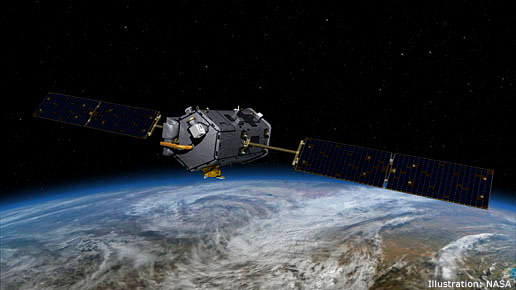
Editor’s Note: The rocket carrying NASA’s Carbon Observatory into orbit failed early Tuesday morning, destroying the satellite. Updates to follow.
NASA hopes to start solving one of climate science’s most vexing mysteries Tuesday morning when it launches the Orbiting Carbon Observatory (OCO), its first spacecraft dedicated to measuring atmospheric carbon dioxide. The satellite is designed to measure the CO2 content of vertical “columns” stretching from the Earth’s surface up to the top of the atmosphere, providing vastly more information than land-based measurements currently supply.
Ultimately, mission scientists hope, the satellite will lead them to the “missing” carbon sinks — repositories of carbon dioxide that haven’t been accounted for in the atmosphere, the oceans, or on land.
NASA’s press office elaborates:
Of all the carbon humans have added to Earth’s atmosphere since the start of the Industrial Revolution, only about 40 percent has remained in Earth’s atmosphere. About half of the remaining 60 percent can be accounted for in Earth’s ocean. The rest must have been absorbed somewhere on land, but scientists cannot yet determine specifically where this is taking place or what controls the efficiency of these land sinks. Scientists refer to this as the “missing” carbon sink.
Locating these sinks is the first step to deciding how to manage them, said OCO project leader David Crisp, of NASA’s Jet Propulsion Laboratory in Pasadena. So where might they be?
“There are a bunch of folks on my team that would vote that the Canadian and Siberian forests are much more efficient than we think they are at absorbing carbon and sequestering it into the soils,” said Crisp.
North American forests could be a significant source as well.
“We’ve been suppressing forest fires for 40 years, letting undergrowth build up,” said Crisp. “There could be a lot of carbon in there.
“I’ve got a couple of team members who are absolutely certain that it’s making its way into the ocean in ways that we aren’t properly accounting for, so we’ll be looking for that … there are lots of ways we could be over- or underestimating the amount of carbon being absorbed into the oceans.
“[And] there are some folks who believe the tropical rainforests, in spite of all the damage they’ve received, are actually responding and growing back in a way that absorbs a lot of carbon.”
In short, nobody knows. Before you start a betting pool, Crisp cautions it will be a year before his team knows if the OCO information will even be useful.
Tuesday’s launch will propel the 1,000-pound satellite into a low orbit, and over the next 30 to 90 days it will climb to about 438 miles. There, it will join a constellation of five other satellites called the A-Train, which gathers data on clouds, ozone, aerosols and other atmospheric information. (NASA’s OCO website has a boatload of information about the mission.)
The satellite’s three high-resolution spectrometers will measure the amount of light in the atmosphere. Based on the refractive qualities of CO2 and molecular oxygen, scientists will determine the relative concentrations of these chemicals, creating a new global map of concentration levels every 16 days.
The mission could also shed light on two other key climate issues: The smaller sources of CO2 emissions and why airborne CO2 levels vary so much over time.
Fossil fuel emissions, which account for about 85 percent of CO2 emissions, are known to within 10 percent accuracy, Crisp said. Emissions from land-use practices related to agriculture and deforestation are much less understood, he said.
“The problem, really, is we just don’t have enough land-based measurement sites,” he said. “We need to take a lot more measurements.”
OCO’s measurements will also establish a record of how CO2 concentrations change over time. While emissions have increased fairly smoothly, the gas’s buildup in the atmosphere varies significantly from year to year. Scientists don’t know why.
At a total cost of $270 million, the project has funding for the next two years. That could be renewed if it produces useful data. Crisp said it’s much less expensive than the laser measurement technology he expects will be NASA’s next step in CO2 measurement.
Underway for more than eight years, OCO survived the Bush administration, which scratched the phrase “to understand and protect our home planet” from NASA’s mission statement and reportedly mothballed another climate satellite that was ready to launch. Crisp sidestepped questions about the former administration, saying only that the Bush team was “generally supportive” of OCO.
The Obama administration hasn’t yet selected a NASA administrator or revealed much of its plans for the agency. (In December a Florida newspaper reported that Bush’s NASA administrator, Mike Griffin, wasn’t cooperating with the Obama transition team.) Phil DeCola, a senior policy analyst in the White House Office of Science and Technology Policy and former OCO program scientist, said OCO and other efforts to solve the sinks mystery (such as Japan’s recently launched climate satellite) have obvious implications for climate policy.
“If the nations of the world take serious action to limit the use of fossil fuels, the right to emit carbon dioxide will become scarcer, and emission rights would become an increasingly valuable traded commodity,” DeCola said in a statement. “Observations of the location, amount and rate of carbon dioxide emission into the air, as well as the stock and flow of all forms of carbon on land and in the ocean, will be needed to manage such a world market fairly and efficiently.”


